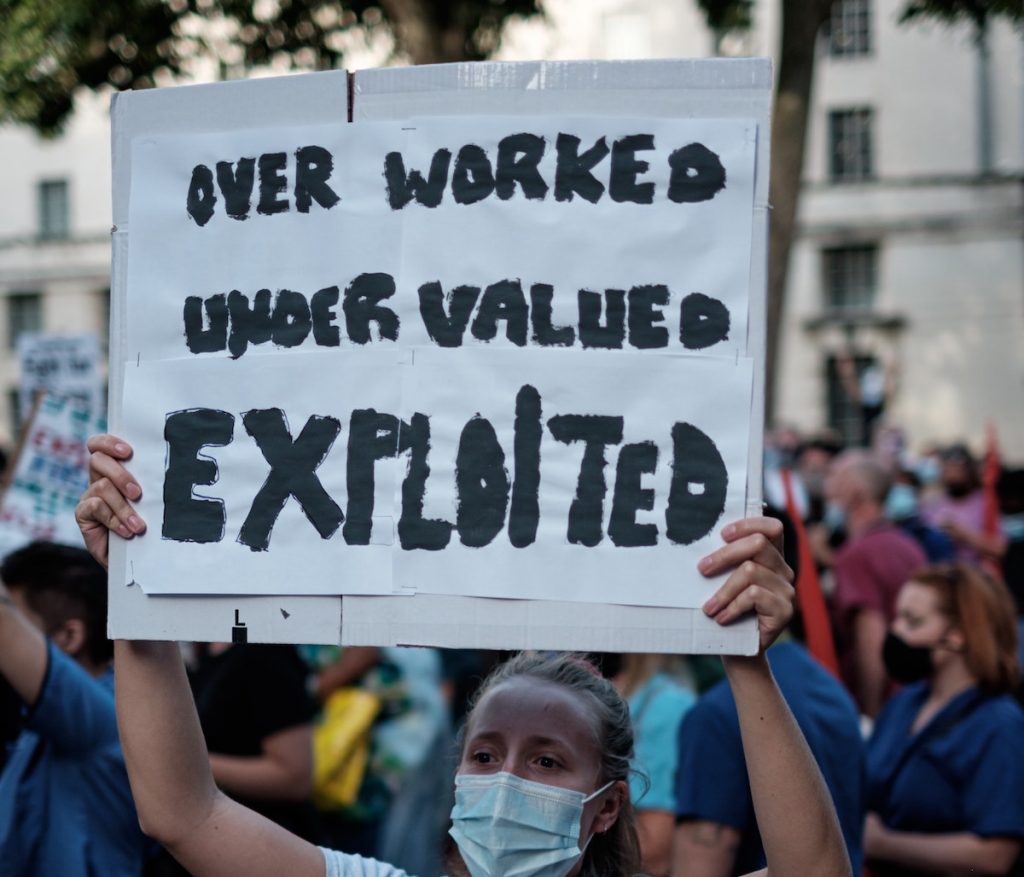By: Zane McNeill

In early February, the bargaining unit at the Center for American Progress (CAP) overwhelmingly voted to authorize any escalation strategies necessary, including strike tactics, to ensure the signing of a fair contract. This escalation in contract negotiations between management and unionized staff was covered extensively by media and instigated a social media frenzy on Twitter.
Advocates of CAP union critiqued the hypocrisy of a progressive organization that fights for national economic mobility paying their own staff a salary wage floor of $40,000 a year in a city where a comfortable living wage requires a $80,000 salary.
Insufficient wages is not just a private sector problem
These workplace issues are not isolated to CAP. Many non-profit organizations have been criticized for not providing sufficient pay and benefits to their employees, which may explain the unionization trend in this sector.
Especially during and because of the COVID-19 pandemic, when the workforce underwent layoffs, furloughs, and pay cuts, nonprofit workers have increasingly begun organizing to ensure fair contracts with their employers. In addition to contract negotiations relating to job security, salary floors, and benefits, the nearly 12.5 million nonprofit workers are also increasingly concerned about staff burnout, racial equity, and standardized pay-scales.
While statistics from the U.S. Bureau of Labor Statistics (BLS) have shown a decrease in union membership in 2021, Katie Barrows, the Communications Director at the Department for Professional Employees, AFL-CIO (DPE) and President of the Nonprofit Professional Employees Union (NPEU), IFPTE Local 70, believe that the BLS statistics do not reflect gains in new industries, such as the non-profit sector, which she has seen major growth in in the past few years.
Non-profits can harness the power of unions to support workers and avoid burnout
Until recently, many people have been under the false impression that “unions are for factories or for construction workers,” says Barrows in an interview with Law@theMargins, “but the modern labor movement, almost half of it, is professionals, so I think it’s somewhere around 44% of union membership today is of professional members, so it’s around 6.2 million professions are in the labor movement.”
Juli Adhikari, a CAP union member, along with Thomas Waldrop and Malkie Wall, former CAP employees, have explained in Nonprofit Quarterly, “What people may not realize is that all types of workers belong to union… As CAP Union members, affiliated with the NPEU, we count ourselves incredibly lucky that our workplace is protected by a collective bargaining contract.”
NPEU has seen major growth since it rebranded in 2018. NPEU currently works with workers employed at more than 48 non-profit organizations. While “the pandemic threw a wrench in bargaining,” explains Barrows, over 30 of NPEU’s units are currently at the bargaining table, either for their first or a subsequent contract. NPEU is anticipating finalizing those contract negotiations and continuing their growth in the sector.
Despite many of the non-profit clients NPEU works who are known for their civil rights advocacy, NPEU has found that employers are often adversarial to their staff’s unionization efforts. “You’ll hear ‘we support unions, just not here,” Barrows said, “which is more common in the progressive space then you’d think.”
I don’t think it’s’ just pay, I think it’s power. The employer no longer has all the power.
Management at organizations like the Animal Legal Defense Fund and Food and Water Watch have been critiqued for engaging in fear-mongering, intimidation, and union-busting tactics, such as hiring law firms that specialize in ‘union avoidance’ strategies, holding 1:1 meetings between a manager and a member of the bargaining committee, and forcing staff to attend captive audience meetings full of anti-union propaganda.
When asked if organizations resort to union-busting because of financial reasons, Barrows responded, “I don’t think it’s’ just pay, I think it’s power. The employer no longer has all the power. It’s now that the members of the union get a voice and get to have a say in decision and that’s scary for a lot of [employers].”
Organizations, such as the Animal Legal Defense Fund, for example, spent a great deal of resources in its attempt to quash its staff’s unionization efforts.
Whether or not leadership embraces unionization, non-profits need stronger labor laws
However, other advocates in the sector, believe that while workers unionizing is a transition for the management team to come to terms with, many organizations come to embrace the union and see the union as a partner in the management of the organization.
Whether or not unions can be embraced by organization’s management and become viewed as equal partners in their organization, workers would still benefit from stronger labor laws. For example, while some states, such as Oregon, ban captive audience meetings, many consider the federal labor law landscape deficient and believe that federal labor law does not adequately protect workers.
“With labor law being so weak, we really do need labor law reform,” said Barrows “There aren’t really any punishment for employers when they break the law and violate worker’s rights…”
Barrows suggests that in addition to strengthening labor law, such as implementing new legislation like the PRO Act, which would impose monetary penalties on employers who broke the law and dissuade corporations from engaging in illegal labor practices, the way to combat union-busting and retaliatory practices from employers is to have a high density of union members in an industry.
“If you’re a well-organized workplace and you’re all standing together and supporting each other and are vocal about it, that provides some level of protection,” says Barrows.
How the PRO Act would affect non-profit workers and unionization
The PRO Act would be especially helpful for non-profit workers as it would expand worker protections, like one’s right to join a union, collectively bargain for better wages, and lobby for increased working conditions.
Specifically, workers would not be mandated to attend anti-union captive audience meetings, which occurred at the Animal Legal Defense Fund, and the PRO Act would prohibit employers from permanently replacing striking staff members, which is increasingly important as organizations like Center for American Progress consider strike tactics during contract negotiations with management.
In addition to reducing individuals’ likelihood of employer retaliation, increasing union engagement across the non-profit industry, especially in larger non-profit organizations which have greater than ten staff members, increases industry standards, like salary floors, across the whole sector. This is why NPEU works with other non-profit unions, such as the Nonprofit Employees United and the Nonprofit Employees United Initiative.
A Declaration of Nonprofit Rights
Other organizations, like Nonprofit New York, supports over 4,000 non-profit organizations and releases salary surveys to ensure fair pay across the sector. In addition, they have released a Declaration of Nonprofit Rights which includes the right to sustainable resources, the rights to engage in advocacy, the rights to be fairly treated as a workforce and a responsibility to champion equality, and the rights to be powerful forces of change.
“The more folks you see organizing the more that motivates the momentum for other folks to begin organizing… We understand that it is good for the whole industry to have more unions in different workplaces, so we want each other [other unions] to thrive,” says Barrows.
What many media outlets have coined as a worker shortage in the nonprofit sector, and the U.S. as a whole, Barrows argues is in actuality a good job shortage:
“A lot of places are not abiding by the rules of capitalism by raising their salaries to attract workers, they’re just like ‘we’re going to offer you this mediocre salary and no benefits, or mediocre benefits, and if you don’t take it there’s a ‘worker shortage’… A lot of us have college debt and then we enter the workforce and had high hopes for our careers and first jobs and our ability to one day buy a house and we’re at these organizations that provide insufficient pay and are struggling to pay their bills. That has made folks look around as say ‘enough is enough.’”




